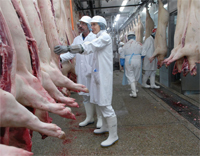EFSA: First stage completed for the modernisation of pig meat inspection

The European Food Safety Authority (EFSA) has completed the first stage of a major piece of work that will provide the scientific basis for the modernisation of meat inspection across the EU.
In May 2010 the European Commission asked EFSA to deliver a series of Scientific Opinions on public health hazards – biological and chemical – to be addressed by meat inspection. The Authority was also requested to provide a summary of comparable data on specific food-borne hazards in the Member States that would enable risk managers to adapt meat inspection procedures to national requirements. EFSA’s experts were asked to consider the implications for animal health and welfare of any proposed changes to current inspection practices.
To fulfil this complex mandate, EFSA has drawn on its expertise in a wide range of fields within its scientific remit and has broken up the work into six sets of Scientific Opinions and Scientific Reports. The first set covers the inspection of swine and is published today.
As well as identifying and ranking the main risks for public health, the scientific experts on EFSA’s panels were asked to: assess the strengths and weaknesses of the current inspection methodology; recommend methods that take into account the hazards not addressed by current meat inspection; and recommend adaptations of methods and/or frequency of inspections based on the hazard rankings and harmonised epidemiological indicators.
In the area of biological hazards, the food-borne hazards Salmonella, Yersinia enterocolitica, Toxoplasma gondii and Trichinella were identified as priority targets in the inspection of swine meat at abattoir level, due to their prevalence and impact on human health. It was concluded that current inspection methods do not enable the early detection of the first three of these hazards and, more broadly, do not differentiate food safety aspects from meat quality aspects, prevention of animal diseases or occupational hazards.
The main recommendations on biological hazards are to:
• Omit the use of palpation and/or incision techniques in post-mortem inspection of pigs subject to routine slaughter because of the risk of bacterial cross-contamination.
• Introduce a comprehensive pork carcass safety assurance framework, combining a range of preventive measures applied on-farm and at-abattoir in an integrated way as this is the only means to ensure an effective control of the main hazards.
• Collect and analyse food chain information (FCI) at herd and abattoir levels to enable a more location-specific assessment of risk.
• Omit the use of palpation and/or incision techniques in post-mortem inspection of pigs subject to routine slaughter because of the risk of bacterial cross-contamination.
• Introduce a comprehensive pork carcass safety assurance framework, combining a range of preventive measures applied on-farm and at-abattoir in an integrated way as this is the only means to ensure an effective control of the main hazards.
• Collect and analyse food chain information (FCI) at herd and abattoir levels to enable a more location-specific assessment of risk.
In the area of animal health and welfare, it was noted that the abolition of palpation and/or incision would lead to a reduction in detection of some diseases but that in cases where several organs are affected, this effect was likely to be minimal. To mitigate the reduced detection probability of the proposed modified system, experts recommend that palpation and/or incision should be conducted as a follow-up to a visual inspection showing abnormalities. The necessity of meat inspection, both ante- and post-mortem – as shown in the 2001 UK Foot and Mouth Disease outbreak – in the overall surveillance system for swine health and welfare, was also highlighted. However, the experts recognised that surveillance information is currently underutilised.
In the area of contaminants, dioxins, dioxin-like polychlorinated biphenyls and the antibiotic chloramphenicol were identified as chemical substances of high potential concern in pork, based on pre-defined criteria. However, it was concluded that chemical substances at the concentrations found in swine meat are unlikely to pose an immediate or short-term health risk for consumers.
The experts recommend:
• the development of risk-based sampling strategies that differentiate between farms producing pigs under conditions of fully implemented HACCP-based protocols and with complete FCI, and farms with less stringent quality control procedures.
• the development of risk-based sampling strategies that differentiate between farms producing pigs under conditions of fully implemented HACCP-based protocols and with complete FCI, and farms with less stringent quality control procedures.
• the encouragement of ad hoc amendments to sampling plans to take account of emerging substances in the food chain.
• and the inclusion of ante- and post-mortem inspection criteria to identify illicit use of substances and encourage analysis at farm level.
EFSA also proposed harmonised epidemiological indicators for food-borne hazards that are covered by existing meat inspection procedures as well as the highlighted biological hazards. The indicators would be particularly useful in the context of the proposed pork carcass safety assurance framework, enabling the categorisation of farms, herds and slaughterhouses according to risk as well as the setting of targets for final chilled carcasses. They would also help risk managers in the European Commission and Member States to decide whether adaptations in inspection methods may be relevant.
Source: EFSA











